Related Research Articles
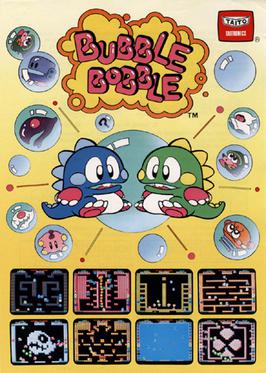
Bubble Bobble is a 1986 platform game developed and published by Taito for arcades. It was distributed in the United States by Romstar, and in Europe by Electrocoin. Players control Bub and Bob, two dragons that set out to save their girlfriends from a world known as the Cave of Monsters. In each level, Bub and Bob must defeat each enemy present by trapping them in bubbles and popping, who turn into bonus items when they hit the ground. There are 100 levels total, each becoming progressively more difficult.
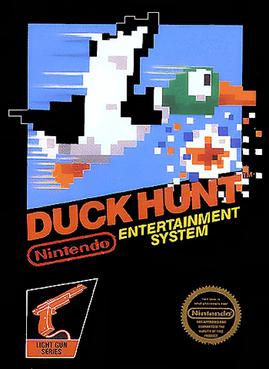
Duck Hunt is a 1984 light gun shooter video game developed and published by Nintendo for the Nintendo Entertainment System (NES) video game console and the Nintendo Vs. System arcade hardware. The game was first released in April 1984, in Japan for the Family Computer (Famicom) console and in North America as an arcade game. It was then released as a launch game for the NES in North America in October 1985, with it also releasing in Europe two years later.

Kid Icarus is a platform video game developed and published by Nintendo for the Family Computer Disk System in Japan and the Nintendo Entertainment System in Europe and North America. It was released in Japan in December 1986, in Europe in February 1987, and in North America in July.

Nintendo Co., Ltd. is a Japanese multinational video game company headquartered in Kyoto. It develops, publishes and releases both video games and video game consoles.

R.O.B. is a toy robot accessory for the Nintendo Entertainment System (NES). It was launched in July 1985 as the Family Computer Robot in Japan, and October 1985 as R.O.B. in North America. Its short lifespan yielded only two games in the Robot Series: Gyromite and Stack-Up.

Contra is a run and gun video game developed and published by Konami, originally developed as a coin-operated arcade video game in 1986 and released on February 20, 1987. A home version was released for the Nintendo Entertainment System in 1988, along with ports for various home computer formats, including the MSX2. The arcade and computer versions were localized as Gryzor in Europe, and the NES version as Probotector in PAL regions.

The Nintendo VS. System is an arcade system developed and produced by Nintendo from 1984 to 1990. It is based on most of the same hardware as the Family Computer (Famicom), later released as the Nintendo Entertainment System (NES). Most of its games are conversions from the Famicom and NES, some heavily altered for the arcade format, and some debuted on the VS. System before being released on the Famicom or NES. The system focuses on two-player cooperative play. It was released in three different configurations: upright VS. UniSystem cabinets, upright VS. DualSystem cabinets, and sit-down VS. DualSystem cabinets. Games are on pluggable circuit boards, allowing for each side to have a different game.
Punch-Out!!, originally titled Mike Tyson's Punch-Out!!, is a 1987 boxing video game developed and published by Nintendo for the Nintendo Entertainment System (NES). Part of the Punch-Out!! series, it is an adaptation of the arcade video games Punch-Out!! (1984) and Super Punch-Out!! (1984). Differences from the arcades include the addition of undisputed world heavyweight champion Mike Tyson as the final boss. It received critical acclaim, and is retrospectively considered one of the greatest video games of all time.
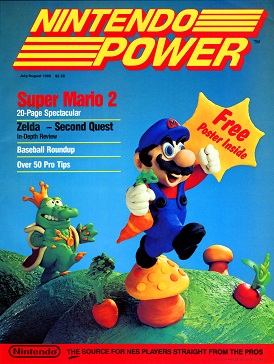
Nintendo Power is a video game news and strategy podcast and former magazine from Nintendo of America, first published in July/August 1988 as Nintendo's official print magazine for North America. The magazine's publication was initially done monthly by Nintendo of America, then independently, and in December 2007 contracted to Future US, the American subsidiary of British publisher Future. Its 24–year production run is one of the longest of all video game magazines in the United States and Canada.
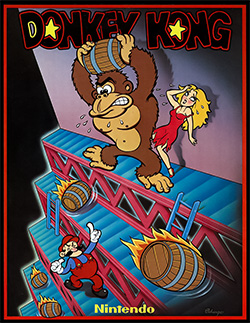
Donkey Kong is a 1981 arcade video game developed and published by Nintendo. As Jumpman, the player runs and jumps on platforms and climbs ladders to ascend a construction site and rescue Pauline from the titular giant gorilla. It is the first game in the Donkey Kong series as well as Mario's first appearance in a video game.
Minoru Arakawa is a Japanese businessman best known as the founder and former president of Nintendo of America, and the co-founder of Tetris Online, Inc.
1995 saw many sequels and prequels in video games, such as Dragon Quest VI, Mario's Picross, Mega Man 7, Super Mario World 2: Yoshi's Island, and Tekken 2, along with new titles such as Battle Arena Toshinden, Chrono Trigger, Rayman, Soul Edge, Twisted Metal, Star Wars: Dark Forces, Destruction Derby, Wipeout and Jumping Flash!

The history of the Nintendo Entertainment System (NES) spans the 1982 development of the Family Computer, to the 1985 launch of the NES, to Nintendo's rise to global dominance based upon this platform throughout the late 1980s. The Family Computer or Famicom was developed in 1982 and launched in 1983 in Japan. Following the North American video game crash of 1983, the Famicom was adapted into the NES which was brazenly launched in North America in 1985. Transitioning the company from its arcade game history into this combined global 8-bit home video game console platform, the Famicom and NES continued to aggressively compete with the next-generation 16-bit consoles including the 1988 Sega Genesis. The platform was succeeded by the Super Famicom in 1990 and the Super Nintendo Entertainment System in 1991, but its support and production continued until 1995. Interest in the NES has been renewed by collectors and emulators, including Nintendo's own Virtual Console platform.
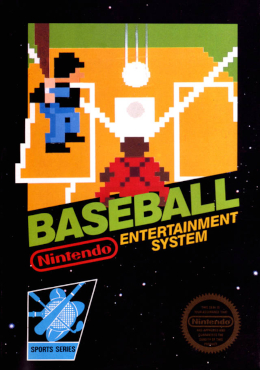
Baseball is a video game from Nintendo. It was released December 7, 1983, after the July 15 launch of the Famicom in Japan. In 1984, it was ported to the VS. System arcade as VS. Baseball with additional graphics and speech, becoming a number one hit in Japan and North America that year. It was localized as a Nintendo Entertainment System launch game in North America in 1985, and in Europe in 1986. IGN said the universal appeal of the American sport made Baseball a key to the NES's successful test market introduction, and an important piece of Nintendo history. The game was also competing with Sega's arcade hit Champion Baseball, released earlier in 1983.
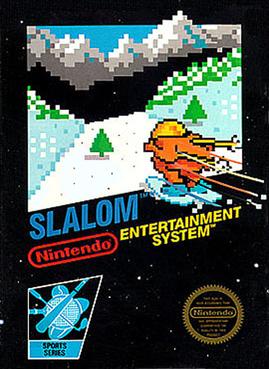
Slalom, originally released as VS. Slalom, is a skiing sports video game developed by Rare and published by Nintendo in 1986 for the Nintendo VS. System in arcades. It was then released for the Nintendo Entertainment System in North America in March 1987 and in Europe later that year. The player races in a series of downhill slalom skiing runs while navigating past flags and obstacles before time expires. It was developed by Tim and Chris Stamper and its music was composed by David Wise.

Nintendo Fun Club was a fan club marketed by Nintendo. It was free to join, and its members received a free subscription to Nintendo Fun Club News, a periodical that discussed popular games and games that were planned for the near future. It also offered tips and tricks, Nintendo video game news, and comics.

The Nintendo Entertainment System (NES) is an 8-bit third-generation home video game console produced by Nintendo. It was first released in Japan in 1983 as the Family Computer (FC), commonly known as the Famicom. The NES, a redesigned version, was released in American test markets on October 18, 1985, before becoming widely available in North America and other countries.
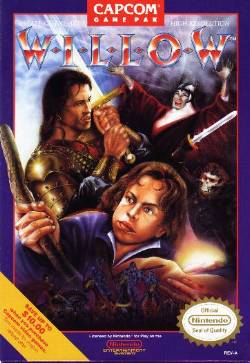
Willow is a 1989 2D action role-playing game developed and published by Capcom for the Nintendo Entertainment System. It is loosely based on the 1988 film of the same name and is the second title Capcom released based on Willow that year, the first being an unrelated side scrolling arcade game. The version of Willow released for the Nintendo Entertainment System and the Famicom is an adventure game in the vein of The Legend of Zelda.
Gail Tilden is an American marketing manager and consultant. She formerly worked at Nintendo of America where she was instrumental in helping with the advertising of the Nintendo Entertainment System's introduction to the North American market, and establishing the Nintendo Power magazine.

The Nintendo Entertainment System (NES), an 8-bit third-generation home video game console produced by Nintendo, had numerous model variants produced throughout its lifetime. It was originally released in 1983 as the Family Computer in Japan, with design work led by Masayuki Uemura. Nintendo intentionally redesigned it as the NES in North America in an attempt to avoid the stigma of video game consoles lingering from the video game crash the same year; while it was initially conceptualized as a home computer, it was ultimately modeled after a videocassette recorder (VCR) for its debut there in 1985. Nintendo subsequently exported the NES to Europe and Oceania via local distributors.
References
- 1 2 "Howard Phillips". The Seattle Times. April 7, 2013. Retrieved July 17, 2019– via Legacy.com.
- 1 2 3 4 5 6 Phillips, Alex (April 2, 2009). "My Dad Was The Game Master". Vice. Retrieved April 15, 2019.
- 1 2 3 4 5 6 7 8 9 10 11 12 13 14 15 16 17 18 Plunkett, Luke (August 28, 2012). "One Man's Journey From Warehouse Worker to Nintendo Legend". Kotaku. Retrieved April 15, 2019.
- 1 2 3 4 5 6 7 Cifaldi, Frank (September 24, 2012). "Nintendo's former 'Fun Club President' wants you to Know-It-All". www.gamasutra.com. Retrieved April 16, 2019.
- 1 2 3 4 McFerran, Damien (October 5, 2012). "Ninterview: Howard "Gamemaster" Phillips". Nintendo Life. Retrieved April 15, 2019.
- 1 2 3 4 5 6 Cifaldi, Frank (October 19, 2015). "In Their Words: Remembering the Launch of the Nintendo Entertainment System". IGN. Retrieved July 1, 2019.
- 1 2 Sheff, David (1994). Game over : how Nintendo conquered the world (1st Vintage books ed.). New York: Vintage Books. ISBN 9780307800749. OCLC 780180879.
- 1 2 3 4 5 6 7 MGC 2019 - Howard Phillips and Frank Cifaldi Interview. Hair of the Dogcast. May 1, 2019. Retrieved July 10, 2019– via YouTube.
- 1 2 Bishop, Todd (October 24, 2012). "5 questions for 'Gamemaster Howard' of Nintendo fame". GeekWire. Retrieved July 18, 2019.
- 1 2 Mary Firestone (2011). Nintendo: The Company and Its Founders . ABDO. pp. 63–. ISBN 978-1-61714-809-5.
- 1 2 Sipchen, Bob (April 27, 1990). "Nintendo Frenzy : Trends: America is in the grips of a computer-game craze. It may affect our future, some experts say". Los Angeles Times. ISSN 0458-3035 . Retrieved July 6, 2019.
- 1 2 Good, Owen S. (October 31, 2015). "Here's how Nintendo announced the NES in North America almost 30 years ago". Polygon. Retrieved July 1, 2019.
- ↑ Corr, O. Casey (May 30, 1991). "The Game Masters". The Washington Post. Retrieved April 15, 2019.
- ↑ Plunkett, Luke (August 22, 2012). "Remembering Nintendo's Other 1980's Magazine, The Nintendo Fun Club". Kotaku. Retrieved December 27, 2015.
- 1 2 3 4 5 6 Cifaldi, Frank (December 11, 2012). "Nintendo Power: Remembering America's Longest-Lasting Game Magazine". Gamasutra. Retrieved July 12, 2019.
- ↑ Wong, Kevin (December 2, 2013). "How We Played With Power: The Secret History of "Nintendo Power"". Complex. Retrieved April 16, 2019.
- 1 2 3 4 5 6 7 8 Phillips, Howard (April 14, 2013). "Interview: Howard Phillips (Ex-Nintendo Power Co-Editor)" (Interview). Interviewed by Michael Levy. Retrieved July 9, 2019.
- 1 2 Cox, Kate (August 30, 2012). "This Long-Lost Nintendo Knitting Machine Would Have Let You Make Sweaters With Your NES". Kotaku. Retrieved July 9, 2019.
- 1 2 Byford, Sam (August 31, 2012). "Nintendo's plans for a NES knitting machine accessory revealed". The Verge. Retrieved July 9, 2019.
- ↑ Parkin, Simon (September 20, 2013). "Postscript: The Man Behind Nintendo". The New Yorker . Retrieved July 12, 2019.
- ↑ Handrahan, Matthew (June 24, 2015). "GameDuell hires Nintendo, Microsoft veteran Howard Phillips". GamesIndustry.biz. Retrieved April 16, 2019.
- 1 2 Ungerleider, Neal (October 3, 2012). "From Nintendo To Kickstarter: Gaming Legend Howard Phillips' Next Act". Fast Company. Retrieved April 16, 2019.
- ↑ Sinclair, Brendan (March 18, 2009). "Howard Phillips pulls up Chair". GameSpot. Retrieved July 11, 2019.
- ↑ Kent, Steven L. (June 16, 2010). The Ultimate History of Video Games: Volume Two: from Pong to Pokémon and beyond...the story behind the craze that touched our lives and changed the world. Crown/Archetype. pp. 762–. ISBN 978-0-307-56087-2.
- ↑ Norman, Kent; Kirakowski, Jurek (December 28, 2017). The Wiley Handbook of Human Computer Interaction Set. Wiley. pp. 301–. ISBN 978-1-118-97726-2.
- ↑ Remo, Chris (March 18, 2009). "Nintendo Veteran Howard Philips To Direct Epic's Chair Entertainment". Gamasutra. Retrieved April 15, 2019.
- ↑ Fletcher, JC (March 18, 2009). "Nintendo icon Howard Phillips joins Epic-owned Chair Entertainment". Engadget. Retrieved July 6, 2019.
- ↑ Kohler, Chris (October 15, 2012). "Know-It-All App Lets You Learn Without Thinking". Wired. ISSN 1059-1028 . Retrieved April 16, 2019.
- ↑ "Gamemaster Howard's Know-It-All". Kickstarter. Retrieved April 16, 2019.
- ↑ Wawro, Alex (June 24, 2015). "Casual game maker Gameduell snaps up Nintendo icon Howard Phillips". Gamasutra. Retrieved April 15, 2019.
- ↑ Handrahan, Matthew (June 24, 2015). "GameDuell hires Nintendo, Microsoft veteran Howard Phillips". GamesIndustry.biz. Retrieved July 6, 2019.
- ↑ Mackey, Bob. "Inside the Howard Phillips Vault: Nine Treasures from Nintendo's History". 1up. Archived from the original on November 9, 2012. Retrieved July 12, 2019.
- ↑ Watts, Martin (March 27, 2013). "Howard Phillips' "Ultimate" Nintendo World Championships 1990 Package Sells For A Whopping $17,367". NintendoLife. Retrieved July 12, 2019.